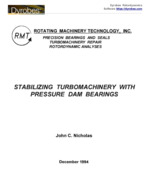Papers
“Stabilizing Turbomachinery with Pressure Dam Bearings,” |
Introduction
Although tilting pad bearings are currently used in the design of a large percentage of the world’s high speed, multistage turbomachinery, there still exists a large class of rotors that are designed or are presently operating with fixed-lobe bearings. Examples include axial compressors, steam turbines, hot gas expanders, and many older model centrifugal compressors. One characteristic of machines that operate successfully with fixed-bore bearings is a low speed-to-weight ratio. This indicates a relatively stiff shaft design and consequently a fundamental mode shape that is nearly rigid. A rigid body mode ensures a significant response at the bearing locations to allow the bearing damping to be effective in suppressing shaft vibrations.
A major problem with many plain and axial-groove bearings is that they exhibit a relatively low oil whirl instability threshold speed that produces a reexcitation of the rotor’s first fundamental natural frequency. Oil whirl is a high speed and/or light load condition. For example, a plain cylindrical journal bearing with a 6.0 mil radial clearance could not operate above 6,000 rpm without whirling. However, many other fixed-bore bearing designs are effective in suppressing oil whirl and thus can operate above 6,000 rpm without becoming unstable. The most commonly used of these are the pressure dam or step journal bearing and the multi-lobe bearing.
The stability characteristics of plain cylindrical bearings are primarily controlled by the bearing clearance; the tighter the clearance, the higher the instability threshold speed. However, tight clearance bearings present other problems that make them undesirable. For example, oil flow is lower, power loss is higher, and thermal growth of the journal may cause the bearing to wipe. Many bearing-induced instability problems in the field are caused by bearing clearances that have increased due to wear from oil contamination, poor filtration, and/or repeated starts and slow rolling with boundary lubrication.
Thus, it is desirable to analyze and design an effective fixed-bore anti-whirl bearing that is easily manufactured, relatively insensitive to design tolerances, and available for quick retrofits in existing plain bearing inserts. The pressure dam bearing falls into this category. The details of the surface inside the pocket are of secondary importance since the side lands hold the flow and the pressure. The hydrodynamic load created by the pocket provides the increased margin of stability for step bearings compared to plain bearings. Finally, the tolerance on the pocket depth is not as critical as lobe-clearance tolerances for multilobe bearings. Tolerances on the lobe radius for multilobe bearings are often on the order of ± 1.0 mils. These tolerances can be relaxed for pocket bearing profiles, which therefore reduces manufacturing costs. Typical pocket depth tolerances are often ± 2.5 mils.
Pressure dam or step journal bearings have long been used to improve the stability of turbomachinery as replacements for plain journal or axial groove bearings. In many cases, these bearings provide a quick and inexpensive fix for machines operating at high speeds near or above the stability threshold. For example, a plain cylindrical axial-groove bearing can easily be removed from a machine displaying subsynchronous vibration. Milling a step in the top pad of the proper size and location may be all that is necessary to eliminate the stability problem. This is much less expensive and faster than installing tilting pad bearings that may require a change in the bearing housing.
A large percentage of the rotors used in the rotating equipment industry operate on vendor installed or retrofitted pressure dam bearings. The most common applications are steam turbines and gear boxes. In high speed gear boxes, the gear loading may vary from several thousand to only a few hundred pounds. This large variance in load is often accompanied by a change in load direction. An example is the gear box between a motor/generator and a start-up steam turbine in a catalytic cracking axial-compressor train. In this particular application, step bearings are used to ensure stable operation when the gear loading is small.
The purpose of this paper is to describe how the pressure dam bearing suppresses oil whirl and to identify the important design parameters necessary to optimize its stability performance. These concepts are extremely important for both rotating equipment vendors and users who design step journal bearings either as original equipment or as retrofits replacing plain bearings.

